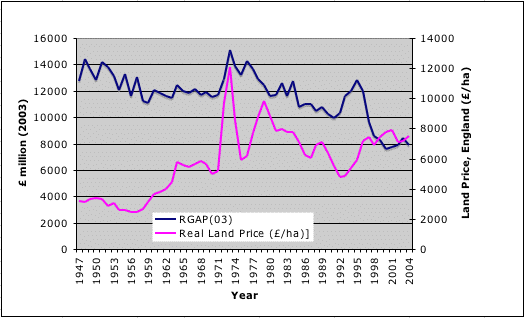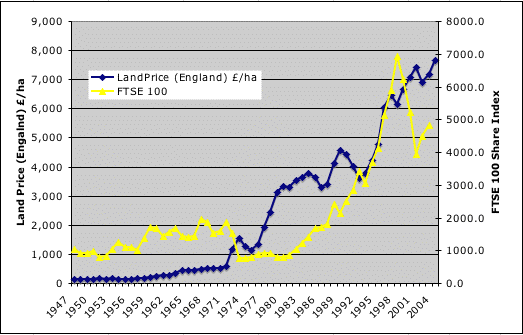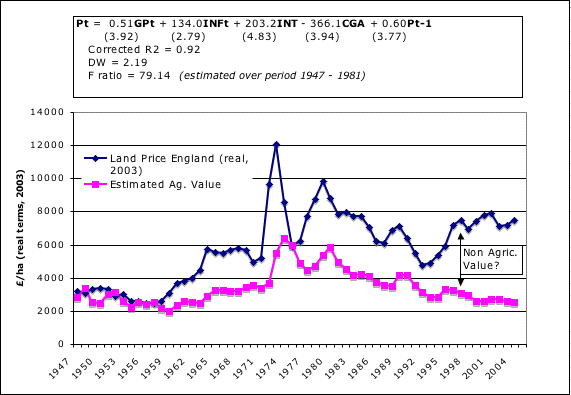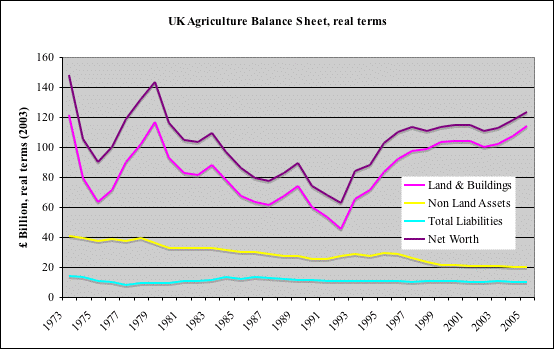ACE2006: The FarmLand Market
Clive Aslet (
UK Land Directory Ltd. 17.05.08) "You
won't need telling that 2008 has not been a particularly jolly year for
property. According to Henry Pryor, of online property portal
Primelocation.com, the price of an average house is falling by
£1,000 a week. But one part of the market is bucking the trend:
farmland (with, of course, farmhouse). You'd be forgiven for having
forgotten it; throughout all those years when the City was booming,
banks were shovelling money into mortgages and property in the south of
England went stratospheric, agriculture was in the doldrums, and the
price of farmland refused to budge. Now, just when the rest of the
market has gone to a darkened room feeling queasy, the farmland market
is galloping away, ruddy-cheeked and jumping five-bar gates.
Farm favourite: the asking price of
more than £10 million for the 1,130-acre Morval estate, at Looe,
on the south coast of Cornwall, reflects the boisterous good health of
the agriculture industry and the performance of farmland in the
property market. Everywhere you go, farmers have eye-popping tales of
fields in their county that have sold for three times what they would
have fetched a few years ago. Figures from Savills estate agency show
that prime arable land increased in value by 26 per cent in the first
quarter of 2008.
James Laing, of Strutt & Parker,
who sells more farmland than any other agent in Britain, thinks it has
further to go. "Land has gone from £3,000 an acre to £7,000
an acre in three years,'' he says. "I believe it will reach
£9,000 an acre. At £9,000, there is still an acceptable
level of profitability in terms of yields. He has just put Grange Farm,
South Kyme - 800 acres of flat, potato-growing south Lincolnshire, with
a Victorian farmhouse - on the market at £6.5million; it would
have been £3million three years ago. As for the credit crunch, no
worries. When the land agents Smiths Gore surveyed lenders last month,
they found the banks just as happy to lend on farmland, still regarded
as a prime asset with a low record of bad debt, as they had been before
Northern Rock upset the apple cart for residential buyers.
It was in 2005 that prices started to
move. There were three stimuli. First, Celtic hordes
swooped on the west coast, via the ferry port of Stranraer. Irish
farmers, having sold land either for development or because the price
of farmland in Ireland had gone into orbit (£20,000 an acre in
some cases), were traditionally distrustful of banks, had too much to
stuff under the mattress and so put their bundle straight back into
farmland in Britain. Second,
Danish farmers, highly efficient but unable to expand in their own
country, followed the route of their Viking ancestors, and devoured the
pickings to be had in East Anglia (even at today's prices, land in the
UK is still cheaper than in Denmark). Third, hedge fund managers
began putting their own funds, so to speak, into hedges: they liked the
lifestyle, had spotted a rising market and, although generally too
young to think about inheritance planning, may be influenced by the tax
advantages of owning farms (because land that is not let to tenants
incurs no inheritance tax, and tenanted land enjoys a 50 per cent
rebate, it is a handy way of passing money to the next generation).
"
It is now some time since I did any research on the UK Agricultural
Land Market (1989!), and very
little has appeared in the literature since then. However, some
comparisons might be instructive.
 This figure compares average English farm land prices for
all sales in real terms (base 2003, deflated by the GDP deflator) -
right axis - with the series of Real Agricultural Gross Product (UK) -
left axis.
This figure compares average English farm land prices for
all sales in real terms (base 2003, deflated by the GDP deflator) -
right axis - with the series of Real Agricultural Gross Product (UK) -
left axis.
Notice the the first serious spike in land price coincided with the
spike in real GDP as a result of the commodity price boom of the early
1970s. This was followed immediately by a correction, and then a
subsequent spike and slower correction - rather typical of asset and
stock market over-reaction and then over-correction. Nevertheless, this
period does indicate that British farming took the dramatic improvement
in farm returns to be permanent - as a consequence of UK entry to the
EU - rather than temporary (as a consequence of emphemeral world market
conditions).
From 1980, the land price in real terms seems to reflect the
performance of farming (as reflected in real GP) until the 1990s, when
the spike in real GP (following the UK's exit from the ERM and
subsequent depreciation of the sterling exchange rate w.r.t the euro),
was not reflected in the price of land, which actually became depressed
through this period. This suggests that macroeconomic influences on the
asset prices (interest and inflation rates) may have been more
important in this period than the agricultural income earning prospects.
Since 1992, however, English land prices have been heading in the
opposite direction to farming returns. Why? Two reasons
seem obvious:
- the system of farm support changed from supporting production to
support being paid on the basis of land areas (crop acreage and
livestock numbers) and, more recently, to the single farm
payment. Hence we would expect that more of the support would now
be captured in the price of land than previously
- Property and stock market prices have been strong in the rest of
the economy throughout this period (with one or two corrections) and
the increase in farm land prices is a reflection of the
non-agricultural demand for land.

This last proposition seems to be supported by a comparison between the
farm land price (in nominal, current terms) with the FTSE 100 share
index (right hand axis) since the ealry 1990s. However, the land
price did not suffer such a major correction in the early naughties as
did the stock market - the land market is, apparently, less susceptable
to speculative bubbles than is the stock market (or the housing market)?
 As a final illustration of the possible mechanics of the
farm land market, this chart shows the performance of a farm land
market model, (explained in detail in the companion paper), which I
estimated in 1989. The estimated real land price here, based on
an estimation period from 1947 to 1981, hypothesises that the land
price (Pt) depends on:
As a final illustration of the possible mechanics of the
farm land market, this chart shows the performance of a farm land
market model, (explained in detail in the companion paper), which I
estimated in 1989. The estimated real land price here, based on
an estimation period from 1947 to 1981, hypothesises that the land
price (Pt) depends on:
- Farm returns (real agricultural gross product (GPt);
- Inflation rate (in % terms) - allowing for the posisbility that
land is treated as an inflation hedge - i.e. that it will at least
maintain its value in real terms whatever the inflation rate, and thus
becomes more attractive in inflationary periods;
- Interest rates - as suggested by the simple theory, though here
showing up with the WRONG sign - as interest rates go up, asset prices
(like land) should fall
- Supply of farm land - measured here as the area of crops and
grass - which does not change very much
- Lagged land price (the price of land in the previous year) - this
variable is included to reflect the likelihood that land prices adjust
to changes in the 'fundamentals' slowly rather than immediately - the
econometrics need not concern us here.
What is quite interesting is that the explanatory equation seems to
perform reasonably well until the 1990s (although the full paper does
indicate that there are some considerable statistical problems with
this equation - for the purists, the variables do not display the same
time-series properties, which they need to for the results of their
correlations to be reliable). However, since the early 1990s, this
estimation (which might be taken as an indication of the agricultural
value of land) has been diverging from the actual land price.
I have not had the time or the resources to get back to looking at the
behaviour of land prices over the more recent periods - but it would
make an interesting exercise for someone!
 In any event, land dominates the industry's balance
sheet, as shown here (data, as above, from Defra, Agriculture in the UK
statistics). Again, these data are in real terms (deflated by the GDP
deflator). The industry as a whole cannot be said to be over-geared -
total assets exceed total liabilities by a very considerable margin -
with net worth strongly positive throughout this period, albeit subject
to variations in the price of land.
In any event, land dominates the industry's balance
sheet, as shown here (data, as above, from Defra, Agriculture in the UK
statistics). Again, these data are in real terms (deflated by the GDP
deflator). The industry as a whole cannot be said to be over-geared -
total assets exceed total liabilities by a very considerable margin -
with net worth strongly positive throughout this period, albeit subject
to variations in the price of land.
Clearly, the land base provides the industry with a very
considerable asset base from which to lever investment funds, though,
by the same token, also representing a major obstacle to entry - if
would be farmers are determined to be landowners as well. If so, it is
clear that farming cannot justify present land prices on present
earnings - so purchase has to be justified in pure asset ownership
terms (resting, in this case, on the expectation of continued growth in
non-farm demand and hence in capital appreciation).
Global future prospects? - for an
excellent and well-structured assessment, see: "The Global Supply and Demand for
Agricultural Land in 2050: A Perfect Storm in the Making?" by Tom
Hertel, 2010
Back to Index
 This figure compares average English farm land prices for
all sales in real terms (base 2003, deflated by the GDP deflator) -
right axis - with the series of Real Agricultural Gross Product (UK) -
left axis.
This figure compares average English farm land prices for
all sales in real terms (base 2003, deflated by the GDP deflator) -
right axis - with the series of Real Agricultural Gross Product (UK) -
left axis.
 As a final illustration of the possible mechanics of the
farm land market, this chart shows the performance of a farm land
market model, (explained in detail in the companion paper), which I
estimated in 1989. The estimated real land price here, based on
an estimation period from 1947 to 1981, hypothesises that the land
price (Pt) depends on:
As a final illustration of the possible mechanics of the
farm land market, this chart shows the performance of a farm land
market model, (explained in detail in the companion paper), which I
estimated in 1989. The estimated real land price here, based on
an estimation period from 1947 to 1981, hypothesises that the land
price (Pt) depends on: In any event, land dominates the industry's balance
sheet, as shown here (data, as above, from Defra, Agriculture in the UK
statistics). Again, these data are in real terms (deflated by the GDP
deflator). The industry as a whole cannot be said to be over-geared -
total assets exceed total liabilities by a very considerable margin -
with net worth strongly positive throughout this period, albeit subject
to variations in the price of land.
In any event, land dominates the industry's balance
sheet, as shown here (data, as above, from Defra, Agriculture in the UK
statistics). Again, these data are in real terms (deflated by the GDP
deflator). The industry as a whole cannot be said to be over-geared -
total assets exceed total liabilities by a very considerable margin -
with net worth strongly positive throughout this period, albeit subject
to variations in the price of land.